Instead of a relay, I would use an optocoupler with a resistor in series. The relay will be an inductive load, which the circuit that drives the backup light might not be designed to handle.
On the output side of the optocoupler you have a collector and emitter of a transistor that is either on or off. This won't be enough to switch the power to your sensor directly, but it can switch something else that can. Two simple solutions for that would be a P channel FET or a PNP transistor. Both would be a high side switch.
For the FET, there would be a pullup on the gate to the source, with the optocoupler pulling it low. Plenty of FETs can take 12 V on the gate, but unfortunately it's not that simple. In a car, there can be significant voltage spikes. Getting a FET rated for 60 V is no problem, but you're not going to find one that will allow -60 V on the gate. One way to fix this is to use a zener diode to limit the gate voltage. That requires an extra resistor in series with the optocoupler output so that the zener has something to work against.
Given all the gate drive problems of a P FET, the PNP solution will be simpler:

When the LED in the optocoupler is on, the output transistor goes on. This brings the bottom end of R1 to nearly ground, and provides about 20 mA base drive to Q1. This times the gain of Q1 is the amount of current it can switch on to power the sensor. For example, if the gain of Q1 is 40, then it can provide up to 800 mA. You want to leave some margin, so that would be good if the sensor is rated for 500 mA.
When voltage spikes happen, the voltage at the base of Q1 goes up. The combination of R1 and the optocoupler output transistor will have this higher voltage accross it. The current will increase, and eventually the optocoupler transistor may not be able to support the higher current, so the voltage across it increases. This increases its dissipation momentarily, but for short spikes this is no issue. It is easy to find optocouplers that can support 25 mA output current or more. The real issue to surviving spikes is to make sure that both the optocoupler output transistor and Q1 are rated for the higher voltage. 60 V should do it for Q1, and the optocoupler output actually gets a little less voltage stress, but these are not hard specs to meet. Some flavor of the cheap and plentiful FOD817 for the optocoupler should do it, for example.
